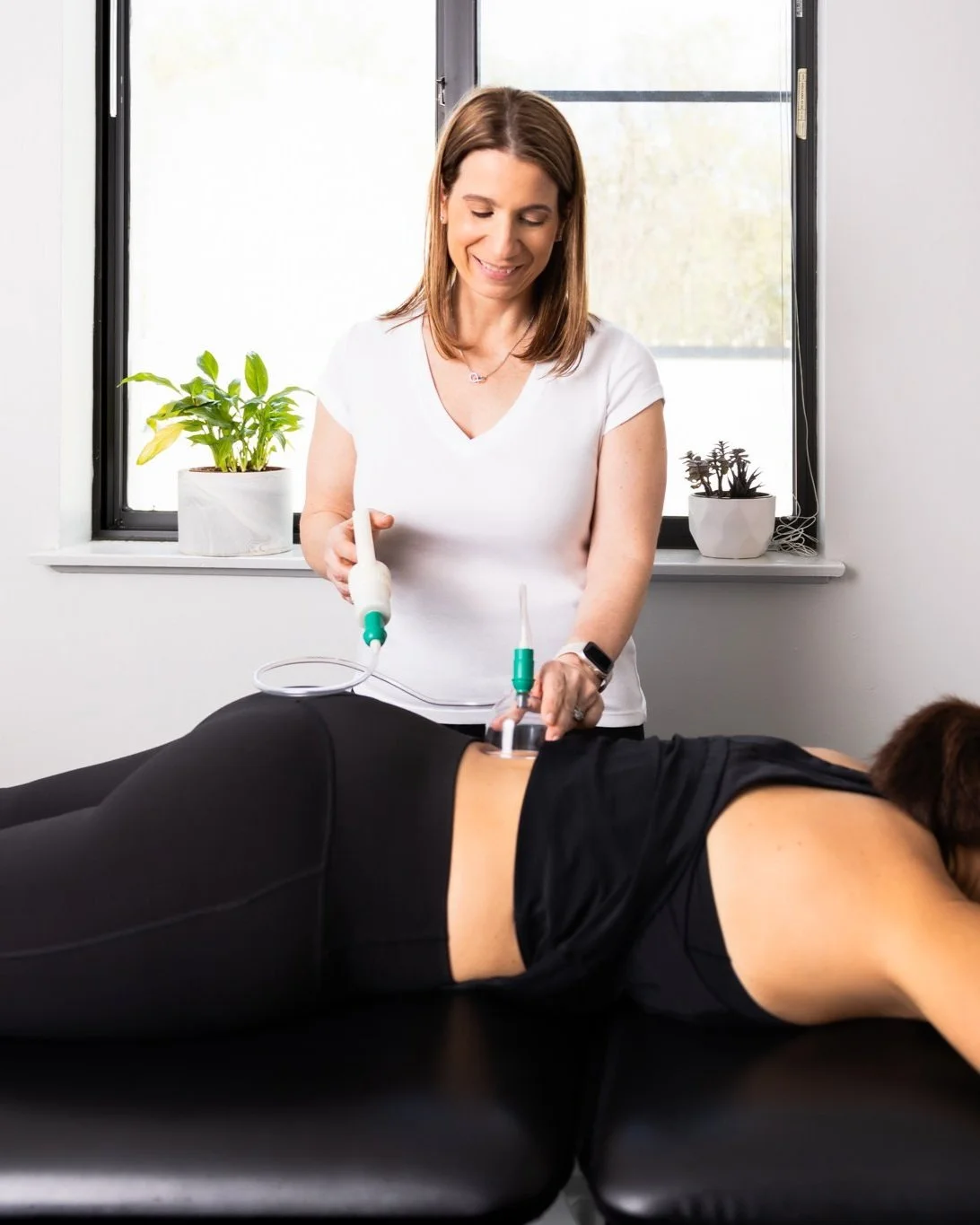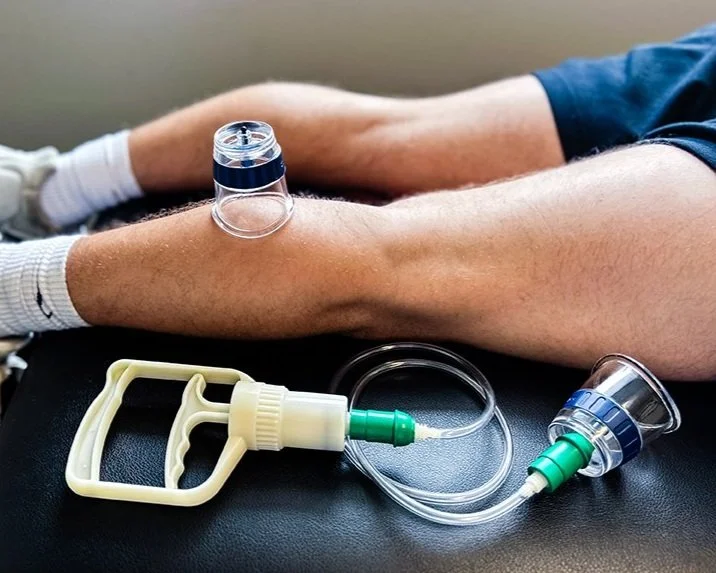Cupping Therapy in Potomac, MD
What is cupping?
(aka Myofascial Decompression)
Traditional cupping therapy dates back thousands of years, originating in ancient Chinese medicine. Today, cupping is used to treat anyone who wants to improve mobility and decrease pain. Athletes also frequently use cupping for injury recovery and management!
Who Can Benefit from Cupping Therapy?
Cupping can be used to treat a range of conditions, including but not limited to:
Chronic back, neck, shoulder, or knee pain
Hip pain
Ankle pain
Chronic headaches and migraines
Sport-related injuries
Post-surgery recovery from sport-related injuries
Fibromyalgia
Soft tissue injuries
Shoulder and scapular dysfunction
Even with its many benefits, cupping may not be right for everyone, so we only offer these services as part of a larger care plan. Everyone must have an initial assessment done before starting any physical therapy plan. We will let you know during your assessment if you’re a good fit for myofascial decompression.
Benefits of Cupping Therapy
Whether you’re experiencing chronic or acute pain, you can benefit from adding cupping to your physical therapy or wellness plan.
-

Reduced Swelling & Inflammation
-

Enhanced Blood Flow
-

Release Tight Muscles
-

Reduced Muscle Spasms
-

Improve Mobility
-

Reduced Scar Tissue Formation
What to Expect During Cupping Therapy
Myofascial decompression, or cupping, uses suction to release tight spots in the muscles and fascia where tissues don’t move well. The results are felt almost instantly, with many of our clients reporting pain relief in the first session!
Cupping therapy lasts just a few minutes and can feel like a deep tissue massage, making it perfect for anyone who wants to improve mobility, decrease pain, or support their recovery process or an ongoing injury.
How Myofascial Decompression Works
Cups are placed strategically in multiple locations to help decompress the soft tissue, muscles, tendons, ligaments, and fascia.
Plastic cups are suctioned onto the body with a vacuum pump, drawing the soft tissue into the cup. This helps soften tight muscles, loosen adhesions, and lift connective tissue to help blood flow more efficiently, reducing pain, swelling, and inflammation.
Cupping therapy, start to finish, lasts no more than 8 minutes.
-
Step 1: Movement Assessment
We analyze how you move so we can determine which structures may be limiting you and creating pain.
-
Step 2: Cup Placement
Using our deep knowledge of anatomy, cups are strategically placed on the body, and suction is used to keep them in place.
-
Step 3: Load and Stretch
To improve mobility and decrease pain, gentle strengthening and stretching exercises may be done while wearing cups.
-
Step 4: Cup Removal and Movement
Suction is released and cups are removed. More strengthening and stretching exercises are used to assess improvements.
What Our Clients Say
“Stacy is the most amazing physical therapist! She's treated me for close to 10 years, and every injury I've had she's taken care of. Her knowledge, skill and experience are beyond amazing, and I have a lot of gratitude that we met all those years ago and she's in my life.”
— Stephanie
Find Out if Cupping Therapy is Right for You
Our Expertise in Cupping (Myofascial Decompression)
You’re in good hands! From former athletes to those passionate about the game, our team has specialized training to evaluate and treat orthopedic injuries, including the use of cupping.
We’ll help you find what works for you so you can get back on your feet and do more of what you love!
-

KinetaCore® certified Functional Dry Needling® Practitioner
-

Certified Integrated Manual Therapist (CIMT) from Great Lakes Seminars
-

Certified Strength and Conditioning Specialist (CSCS) through the National Strength and Conditioning Association
-

Sportsmetrics™ Certified Trainer for ACL prevention in female athletes
-

Pilates certified for rehabilitation through Polestar Pilates
-

Certified Functional Medicine Health Coach through FMCA and IFM
-

Health advisor to the Maryland State Youth Soccer Association
-

Best of Bethesda: Won in 2017 and was “top vote getter” 2019, 2020, 2023, 2024
-

Presented “Overuse Injuries in Soccer: Prevention, Identification and Recovery” at the NSCAA Annual Convention, Baltimore, MD, January 2016 (NSCAA = National Soccer Coaches Association of America)
Meet the Team
Dr. Stacy E. King
PT, DPT, OCS, CIMT, CSCS
Owner, Lead Physical Therapist, former athlete, and 2x hip replacement patient.
Learn more about Dr. Stacy E. King, and the rest of the Aspire PT & Wellness team here!
Frequently Asked Questions
Have more questions?
-
Cupping therapy can be painful. Think of it like a deep tissue massage, which can sometimes be fairly intense if you have knots or injuries. Of course, our physical therapist can always adjust the pressure/duration of your treatment based on your comfort level.
-
Number of sessions will depend on your treatment plan and duration. Most clients can expect 1 session per week, but the number of sessions is based on how well your body responds to the treatment.
-
Item descriptionIf you have very sensitive skin, we do not recommend cupping as physical therapy. However, we can discuss your options during your assessment.
-
Marks that look like bruises sometimes appear after cupping. This is because the small capillaries may rupture during the procedure. Bruising is common but usually clears up within a week for most individuals.
-
All bodies are different, but most cupping marks will disappear 2-10 days following your treatment.
-
No, myofascial decompression does not leave lasting scars or marks.
Book Your Myofascial Decompression Session
Reduce muscle pain and tension as you recover. Schedule an assessment and ask us about how to add myofascial decompression to your physical therapy plan!



